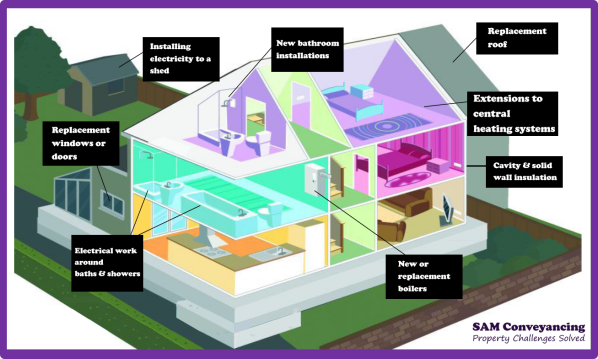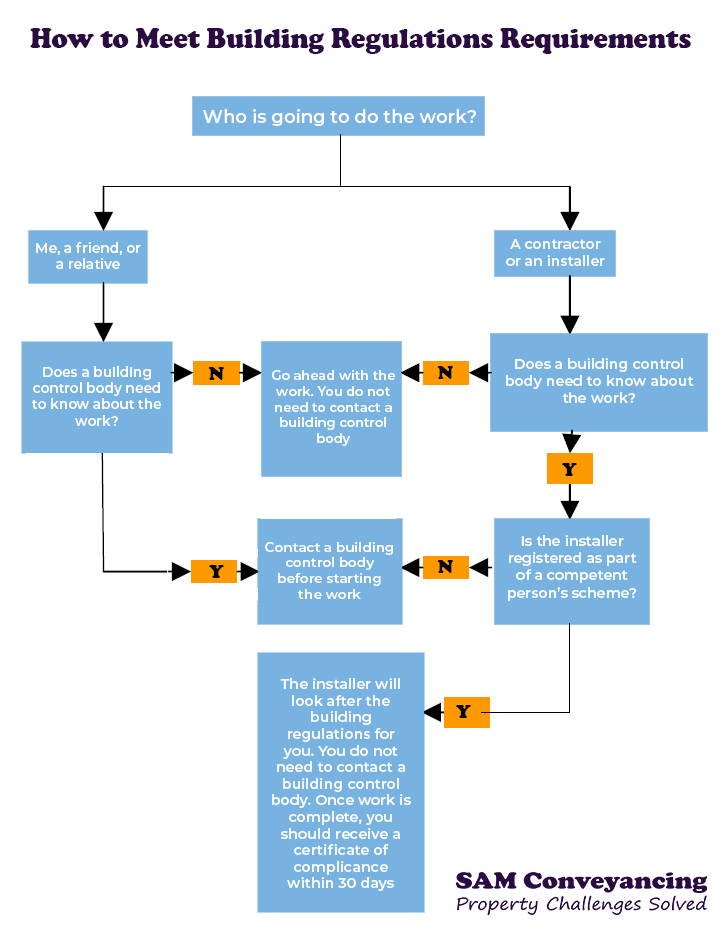What Are the Building Regulations in England and Wales?
- The building regulations in England and Wales are the minimum legal standards for the construction of building projects, to ensure homes are safe and fit for purpose.
- They cover workmanship; materials; structural safety; water/weatherproofing; fire safety & escape; ventilation; fall risk; water, drainage & sanitary facilities; sound & heat insulation; accessibility; electricity, gas & heating; windows & doors; and more.
- Fees can vary but depending on your project, you can expect to pay between £250-£800 for your application and inspection.
- Contractors who are members of a competent person's scheme can sign off certain work themselves, saving you the hassle of submitting plans and regular inspections.
What are building regulations?
They are the minimum legal technical standards for construction the Government has put together and apply to the majority of building projects. The regulations ensure that buildings are safe, energy-efficient, and have reasonable access for all.

Both Building Regulations and planning permission are concerned with producing similar outcomes about the quality of building work but they are two different types of approval.
Depending on your building project you may need both, so it is important to check what is required before you start work. For example, for an extension or loft conversion, it's normal to get planning permission before you get building regulation approval.
Planning permission deals with issues concerning the impact of a building on its surroundings, including matters of appearance, traffic, access, pollution, and similar environmental issues.
What happens if I don't get building regulations approval?
- If you do not comply, the work will not be legal. You could be prosecuted and could face unlimited fines.
- The work may not be safe and could cause health problems, injury or even death. It may also not meet energy efficiency standards.
- If work is found to be fault your Local Authority could insist you put it right at your own expense.
- If the work has not been notified to a Building Control Body or carried out by a Competent Person Scheme registered installer the Local Authority will have no record that the work complies with regulations.
These approved documents will be important when you come to sell your home as you will be asked to provide certificates of compliance with the regulations.
It is possible to get retrospective sign-off through Regularisation; however, this is more expensive and time consuming than getting approval in the first place, and will require more work to be done if it is not already in line with code.
Alternatively, you can cover the interests of the mortgage lender with indemnity insurance, as long as the local authority remains unaware of the unauthorised works. But, this does not protect the owner or occupier from dangerous works. If you're stuck with completed work which is missing the necessary certifications, we can help with an assessment from our structural engineer.
Our structural engineer will attend the property to inspect the unauthorised works for compliance with Building Regulations - Part A: Structure.
This is an intrusive survey. The report will:
- Confirm that the works appear compliant and simply need to be signed off by building control.
- Outline any works required to make the work structurally compliant before bringing a building control inspector in to grant the letter of regularisation.
- Confirm that the work would need to be completely undone or redone to meet building regulations.

When do I need approval?
Among the most common proposals which require approval are:
- Most house extensions.
- Conversions of buildings to houses or apartments.
- Conversions of garages or outbuildings to form rooms.
- Loft conversions.
- Fitting roof lights or dormer windows.
- Internal structural alterations (including removals of load-bearing walls or chimney breasts.
- Some domestic electrical work projects.
- New baths, showers, sinks, or toilets when new drainage or waste plumbing is required.
- A new opening or widening of an opening in a load-bearing wall
- Window and door replacement (unless installed by a FENSA, CERTASS, or BSI approved installer).
- Septic tank installation.
- Cavity wall insulation.
- Installation of new heating (other than electric and subject to certain exceptions).
You may also have responsibilities under The Party Wall Act.
Read the official HM Government guidance.
What projects are exempt from needing building regulations?
Some examples are:
- Porches (used as entrance area and separated from the rest of the house by a standard external door).
- Conservatories at ground level and 50% of the walls glazed.
- Detached garages and single-storey buildings at least 1 metre away from the boundary or made from non-combustible material.
All 3 of the above must have an area less than 30 square metres.
Please note that installing electricity to a shed and/or extensions to central heating systems may not need to be notified in certain circumstances.
How do you apply for building regulations approval?
You should apply to the Building Control Department of your local council or use Approved Contractors who self-certify their work.

There are two ways to get approval.
Full Plans Application
This method is often chosen for most projects and required for certain types of work. You need to submit detailed plans, usually drawn up by a structural engineer, architect or other professional plan drawer. The advantage is that a building control surveyor will inspect your application to ensure compliance with regulations before work begins, helping to avoid wasted work and costs.
In our recent survey, 16% of homeowners found defects; including 2% who were able to pull out of a bad purchase, 7% who were able to negotiate a better price, and sadly, 7% of homeowners who did not get a survey and discovered defects after the purchase.
12 of the 39 who remembered how much these defects cost to remedy spent over £5,000
Don't burn your money, book a survey.

Building Notice Application
You can use this method for minor works on domestic properties as long as you're confident you won't need the plans to be checked. However, it carries more risk than a full plan application. If you take this route, the builder you use must understand Building Regulations.
You will need to submit a form to Building Control outlining your project, and the construction must be approved by the building control surveyor.
It's important to communicate your intentions clearly to the surveyor before starting the work to prevent mistakes.
What information do you have to supply with a Full Plans Application?
- 2 copies of drawings for the proposed work showing full details of construction and materials to be used and at a scale of 1:50 and not less than 1:100. Drawings should include plans, sections and elevations of the work as existing and as proposed.
- 2 copies of a site location plan to a scale of not less than 1:1250 indicating site boundaries.
- 2 completed copies of full plans application forms and the correct plan fee for the work.
- Additional information such as structural calculations must also be included.
Building regulations costs
Fees vary from council to council and according to the time taken to process your application, but depending on your project you normally have to pay between£250 - £800.
For the full plans application method, you pay part a fee with your application and, in most circumstances, an additional fee later to cover site inspection costs. For building notices, you pay the same fees but in full when you submit your building notice form.
When can you start work?
You can legally start work 48 hours after you've made your application, using either method. You start work at your own risk using the full plans application however until your plans have been approved.
How do the inspections work?
Your building contractor must be knowledgeable about which projects require inspection and when they must inform Building Control about them to schedule an inspection.
For instance, you need to notify Building Control when building new structures and extensions once your construction reaches the damp-proof course level. This is normally when the brickwork is just above the ground and before any ground floor concrete is laid.
An inspector may conduct site visits to allow Building Control surveyors to verify that insulation, damp-proof membrane, and reinforcement are installed correctly.
If you're unsure whether you need building regulation approval, always consult your local Building Control department. For example, carrying out any loft extension or conversion without approval is illegal; you need approval at the point when you create a new floor.

Can certain jobs be self-certified by appropriate contractors (i.e. they don't need local authority inspection)?
The following renovation projects need to meet regulations for approval, but they can be carried out and self-certified by relevant contractors.
Replacement of windows and doors - only for domestic work. Contractors must be registered with self-certifying schemes run by the British Standards Institute (BSI), CERTASS, or FENSA. You must keep the certification (such as a FENSA certificate) because if you decide to sell, it's proof that your work was carried out legally.
Domestic electrical installations - electrical contractors registered with an approved Competent Persons Scheme can self-certify their work. These schemes can be inspected on the Communities and Local Government website.
Gas appliances - contractors must be listed as Gas Safe Registered Installers.
Solid fuel appliances - contractors must be registered with the Heat Equipment Testing and Approval Scheme (HETAS). This waiver only applies when the rated heat output is 50 kW or less and the building involved is no more than 3 storeys high, otherwise Building Control inspections will be required (excluding any basement).
Oil appliances - contractors must be registered with the Oil Firing Technical Association for the Petroleum Industry (OFTEC), BESCA, or NAPIT Certification Ltd. Heat output from combustion appliances cannot exceed 100 kW and the building cannot exceed 3 storeys (excluding any basement).
It's important to note that although contractors can self-certify, they must also inform the local building control authority that they have carried out the work to the appropriate legal standards. This is for your protection and the protection of consumers in general. If they fail to do so, they are breaking the law.
Why choose someone who is registered with a Competent Person Scheme?
- If the worker is registered with a Competent Person Scheme, they can carry out work in compliance with Building Regulations. They should issue you a certificate or notify the local authority. If you don't receive a certificate within 30 days, contact the Competent Person Scheme operator.
- If you don't use a registered installer, you'll need to submit a building notice and pay a fee to arrange a building inspection.
- You'll also get financial protection for non-compliant work if the company goes out of business.
How can I find an installer registered with a Competent Person Scheme?
Visit Gov.UK, or for electrical work, you can visit www.electricalcompetentperson.co.uk and enter your postcode or the name of the installer in the relevant search box.
Approval of works already carried out
When historic work has been carried out without approval, as long as it was carried out on or after 11 November 1985, you may be able to get retrospective approval. This is called regularisation.
As a property owner, you are not required to apply for a Regularisation Certificate. The local authority is also not required to accept an application or certificate if they believe the building work does not comply with the regulations.
The fees for a Regularisation Application are higher than usual, and if you decide not to proceed with the necessary work, the fees paid are non-refundable. You may also have to provide additional information such as structural integrity calculations.
A different avenue you can pursue is to get indemnity insurance for the work.
Which laws underpin the regulations and Building Control?
For England and Wales, the regulations and accepted practices and standards are set out in the Building Act 1984.
This original Act of Parliament has regularly been updated, rewritten, and consolidated. The most current, and fully rewritten, version is the 2010 Act. This has itself been amended several times, most recently in 2022.
Building practitioners and inspectors must have full knowledge of requirements and guidelines given in separate Approved Documents.
Depending on their area/s of expertise, they will also have to be aware of many other pieces of governing legislation, for example, electrical installation work, plumbing work etc.
If you think that building work carried out in a property you are looking to buy or have bought is unsafe, you should never assume that Building Regulations were not in place at the time.
You may get retrospective building control sign-off for the work if you are looking to put the property on the market.
As referred above, another avenue to pursue is to get indemnity insurance for the work.
We can help with your sale or purchase
Our RICS surveyors can put your mind at ease by providing a comprehensive report and advise if the property adheres to the current regulations.

Andrew started his career in 2000 working within conveyancing solicitor firms and grew hands-on knowledge of a wide variety of conveyancing challenges and solutions. After helping in excess of 50,000 clients in his career, he uses all this experience within his article writing for SAM, mainstream media and his self published book How to Buy a House Without Killing Anyone.
Caragh is an excellent writer and copy editor of books, news articles and editorials. She has written extensively for SAM for a variety of conveyancing, survey, property law and mortgage-related articles.










